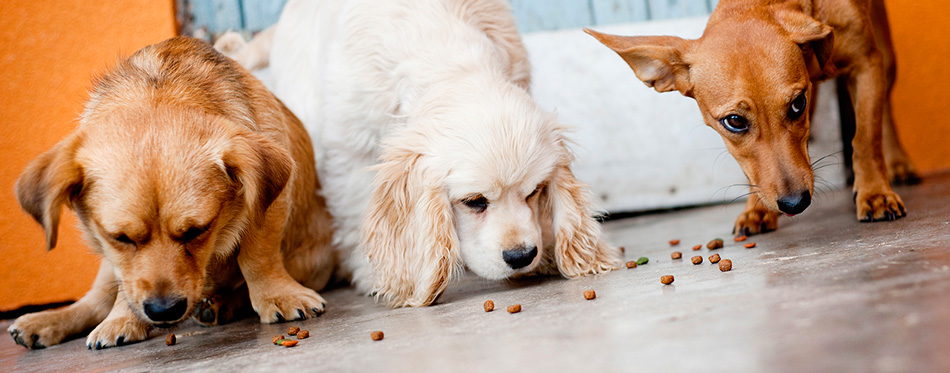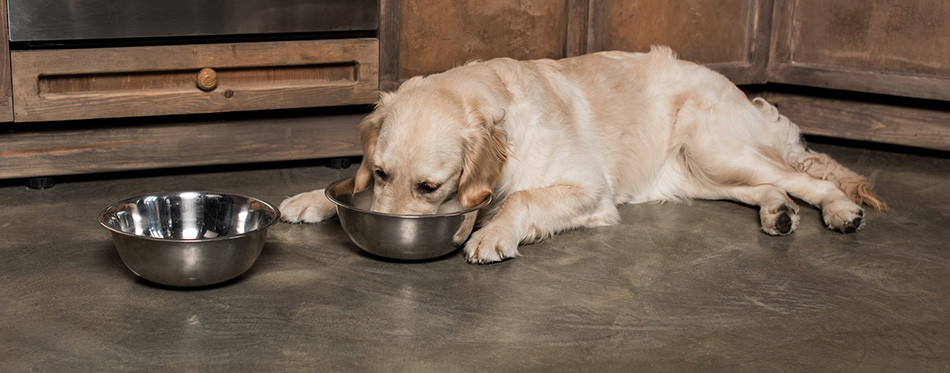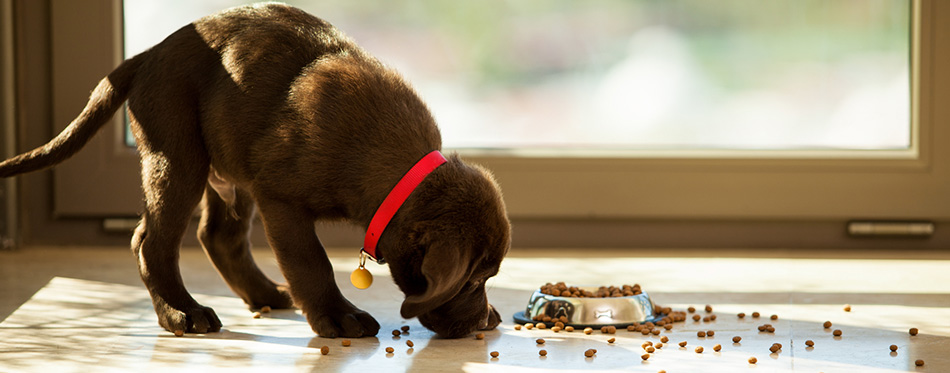Dogs are of course a human’s best friend. They accompany us (or force, depending on your point of view) on walks and supply us with endless love and affection. But it’s not often that we consider the digestive health of our furry friends. However, it is crucial that we’re up to speed on this subject to make sure that our dalmatians to our dachshunds are staying fit and healthy.
When thinking about dogs, food and digestion, the central question people tend to ask is how long does it take for a dog to digest food? This is important to know, so that you can look out for something that isn’t quite right with your pooch. However, it is also important to understand the basics of the canine digestive system.
If something is amiss with your dog’s eating habits, it could be symptomatic of a digestive problem, so it’s important that you know what to look out for in your dog.

The Dog Digestive System
Before we answer the question of how long for dog to digest food, we’re going to take a look at the digestive system of a dog. The digestive system of a dog is fairly intricate, so we’ve boiled it down to the simple facts here.
It is essentially divided into four parts: the mouth and oesophagus, the stomach, the small and large intestine, and the colon.
Take a look at our review of Probiotics for Dogs for more info.
The Mouth and Oesophagus
The digestive process of dogs begins with your pup eating an – appropriately sized – portion of delectable dog food. The dog uses its front teeth to grab the food and then pulls it towards the back of its mouth to grind the food into smaller chunks using its molars. Once the food has been ground down into small enough pieces, it is swallowed through the oesophagus, which is very muscular, and into the stomach.
Saliva in the mouth and oesophagus enables the dog food to be swallowed more easily. However, it is interesting to note that the role of saliva and enzymes in the digestive process differ between humans and dog. In human, saliva contains enzymes and bacteria, which help to break down food in the mouth. This is less the case for dogs, in which saliva acts more as a lubricant to aid with swallowing.
The Stomach
In a dog, the stomach primarily acts as storage facility in which food is collected ready to be converted into energy when required. In fact, a dog’s stomach is designed to expand well beyond its typical daily limits. This is to accommodate for long periods without food – but of course we hope that our dogs don’t necessarily have to utilize that feature!
The stomach of a dog is a highly acidic environment, and here, digestive enzymes are added to the food. This is very helpful for a meat heavy diet. The stomach also regulates how much food is deposited into the small intestine, and at what rate.
The fluids secreted into the stomach include protein digesting enzymes (proteases), hydrochloric acid, and mucus. These all help to turn the food into a thick milky liquid called chyme, keeping that digestive process moving. From the stomach, this liquid moves into the small intestine (where the magic happens).
The Small and Large Intestine
The small intestine is where the central part of the digestive process happens. Despite its name, the small intestine can actually be up to three times the length of the dog itself. In fact it makes up about 25% of a dog’s digestive system.
It has three main parts: the duodenum, the jejunum and the ileum.
The Duodenum
This is the main site in which digestion takes place in the small intestine. In this part, more enzymes are added from the intestinal wall, liver and pancreas, to the already partially digested food, which reduce the level of acidity.
The Jejunum
This is the middle and longest section of the small intestine. It is where the broken down food is finally absorbed into the body. This happens through small, finger-like tentacles, which hang below the surface of the jejunum. They absorb the food by essentially sucking up the nutrients from the pulverized food.
As the nutrients from the food are absorbed, the remaining food essentially turns into waste, which is passed into the final section of the small intestine – the ileum.
The Ileum
This is the shortest section of the small intestine. This absorbs any remaining nutrients, but its primary function is as connective tissue between the small intestine and large intestine of the dog.

Large Intestine
By the time food reaches the large intestine in a dog, most of the nutrients have been absorbed into the body. So the primary role of the large intestine is to absorb water and to partially ferment dietary fiber. This process is responsible for the (not so) rare occasion on which your dog gets a little gassy.
The removal of water at this point is important as it prevents the dog from becoming dehydrated.
The Colon
This is the final part of the dog digestive system. The remnants of the waste food move from the large intestine of the dog into the colon, at which point it becomes fecal matter (nice). It is then deposited via the anal sphincter into a choice location where, hopefully, you will be standing with poop bag at the ready.
Check out our guide on Dog Vitamins.
How Fast Do Dogs Digest Food?
The rate at which dogs digest their food depends on several factors, but the broad average is between 8 and 10 hours. However, it can take as little as 4 hours, or as much as 12 hours. Interestingly, this is significantly quicker than humans, who take between 20 and 30 hours to completely digest a meal.
Between 4 and 12 hours is a fairly big window, so let’s take a closer look at some of the factors that impact dog digestion time.
- Size And Breed
This is a big factor (if you’ll pardon the pun), which makes sense, as it changes the size of the dog’s digestive system. And there’s a pretty big range of size and breed of dogs out there – a fully grown dog can be as little as a 5 lbs Chihuahua or as big as a 120 lbs Anatolian Shepherd. Smaller dogs have smaller intestinal tracts, and as such digest food more quickly.
- Age
This is partially related to the weight of the dog, but primarily relates to metabolism. Generally the older the dog, the longer the time to digest. This also means that puppies needs to consume (and digest) food more regularly than fully grown adult dogs. Also, because a puppy is continually increasing in size, it requires a more nutrient-rich diet
- Exercise
The more exercise dogs do, the faster they use the energy stored, and so digest food faster. So depending on the level of exercise your dog does, you will need to adjust their food intake accordingly. The more exercise they do, the more food they require to keep up their energy, and provide us humans with much love and attention.
- Food
Whilst this might be an obvious one to point out, different foods digest at different speeds. For example, grains are digested more slowly than protein.
In terms of volume of food, the rule of thumb is one cup of dry dog food per 30 pounds of the dog’s weight per day. Dry food is often heavily grain based, whereas wet dog food typically has a higher protein content, and is generally more calorific. There isn’t necessarily a right or wrong with which one to pick, but it is important to consider how to incorporate the right balance of nutrients in what you feed your dog to keep them fit and full of life. If you have queries on this topic, you should talk to your vet.

Dog Digestive Problems
Dogs appetites can be variable, but if you find it changing drastically or for a sustained period of time, it could indicate an underlying health problem. In fact, 10% of visits to the vet are for gastrointestinal diseases, so it’s certainly not uncommon.
Some symptoms to watch out for include loss of appetite, vomiting, diarrhea, constipation, excess gas, straining when passing stools or blood or mucus in the stools. These could be as a result of digestive problems in your dog, such as gastroenteritis, colitis, stress diarrhea, or constipation.
So, whilst it might not be the most glamorous of activities, you should familiarize yourself with your dog’s digestive habits, including how often they go, and what the consistency of their little gifts are like. That way you can be in a good place to know if there is something abnormal going on.
If you do see your dog displaying any of the symptoms we’ve discussed, you should seek help from your vet. Usually it will be a simple fix from the vet to help keep your pooch in prime health.
Source:
- Digestive System of the Dog – Washington State University

